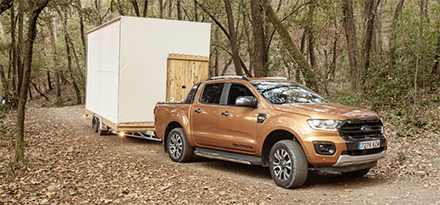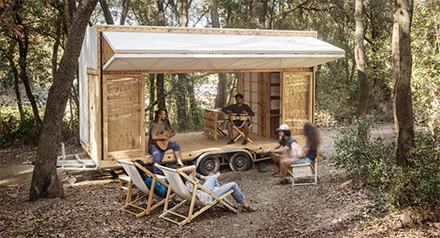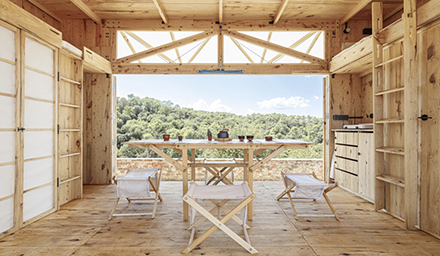The Mobile Catalyst (MO.CA) is an advanced and ecological mobile home built using ‘zero-kilometre’ natural materials and digital construction techniques produced by the students and researchers of the Master in Advanced Ecological Buildings & Biocities program at Valldaura Labs, Spain. Source: Timberbiz
The brief was extended from its initial definition of a home and developed to comprise an experiential engagement facilitator – a mobile catalyst – and thus the design was named MOCA.
The main limitations arose from the trailer on which the home rests and local regulations. The final solution includes a platform 5.4 long and 2.4 wide on which the 3.6 m high house rests. The regulations also establish that the total weight of the construction (together with the trailer) cannot exceed 3,500 kg, and that the driver of the vehicle transporting the trailer must have Permit B96; values that became references and factors that influenced many design decisions.
The design of MO.CA consists of two anchoring, solid toolboxes that contain tools and surfaces designed to initiate different activities in the central ‘reaction chamber’. The Toolbox A or Utility Toolbox is towards the front of the trailer and is the heavier toolbox. It includes all necessary utilities for a home; a kitchen, a shower area, a toilet, and a utility cabinet for electric and water metabolic systems.
The Toolbox B or Activity Toolbox contains surfaces and tools that aid in activating the central space. An entrance door is provided on the Toolbox B side. It serves as the main access when the facade is closed or otherwise. The walls of the toolboxes are made with dowel laminated timber (DLT) panels of 4 cm thickness, mitigating the need for conventional toxic adhesives and maintaining the potential for circular reuse.
The operable facade of the mobile home consists of two complementary layers – a set of glass doors and a fabric facade – that together make it possible to adapt the degree of enclosure of the central space, adapting to the weather conditions, the time of day and the activity happening within.
The glass doors (four on each side) are designed to be either open, semi-open or closed. When closed, the central space is sheltered from the outside environment. When open, the interior/exterior boundary is dissolved. The outer layer is designed as lightweight timber frameworks covered with a water-resistant cotton fabric, secured with threaded cord. On the two long sides, the facade slides and folds up with the mechanical advantage of pulleys.
The mobile home obtains all of its energy from the sun and is equipped to sustain 24 hours of use without recharging. The energy consumption majorly consists of the media-related activities taking place inside and some basic home appliances. In line with the light fabric envelope placed on the roof, a set of 3 light-flexible monocrystalline solar panels connect to a MultiPlus inverter (which can also be connected to an external grid) and a battery backup. The interior and envelope are lit with LED strips, accentuating the textile enclosure with an internal glow.
Two beds (or sleeping shelves) are included on the mezzanine floor to leverage the verticality of the toolboxes (one of them extendable to two places). It comes with an extendable mattress that allows space for two people. A movable ladder accompanies the bed and is attached to the edge of the bed frame, which can be inclined for easier accessibility.
The kitchen includes a sink, a one-burner stove and drawers under the kitchen counter. A fridge is also provided along with spaces to hang utensils. Indicators for the battery level and tank water level are fitted at the kitchen wall.
The washroom includes a waterless humus toilet box and a shower area. The humus toilet system does not include water for flushing, thus, eliminating any blackwater produced except that from cooking or cleaning. This saves the hassle of disposing of or treating black water.
The shower water is collected in a catchment basin and stored in the grey water tank. It is then filtered and pumped to the recycled water tank and reintroduced to the system. The water is treated through a three-stage filter system, followed by a UV filter. The faucet handles permit inhabitants to switch between the water from the fresh water tank or the recycled water tank depending on their intended use. An inlet allows water to be pumped from external sources as well.
The water from the kitchen sink is stored in the black water tank. This water is drained to external infrastructures for treatment. All water tanks are placed beneath the flooring, connected to the trailer, freeing up space for other utilities. The system works on a 12 V battery charged by solar energy, powering three circulatory pumps. Ball float sensors in tanks and a tank water level indicator have also been included for efficient maintenance.
Toolbox B features a wardrobe storing the custom furniture. When outside, the furniture activates the space to host a variety of activities, for instance an office, workshops, exhibitions or concerts. The furniture is designed to fold and to occupy minimal space in this tiny home.
The design is a combination of timber, fabric and dowels making for a lightweight setup. The integrated set includes a table, six stools, two lounge chairs and six Fab-kits. A pair of fabric belt straps are used to secure the furniture when the mobile home is on the road.
The doors of the wardrobe are made with timber and fabric. These doors are also lightweight and follow a similar design style as the rest of the furniture with the fabric being a key element.
Fab-kits, stored behind the mezzanine ladder and at the entrance door, include a first-aid kit, a fire extinguisher, and space for books, footwear, laundry and other objects. Underneath, 3 entrance ladders can be stored when not in use.








